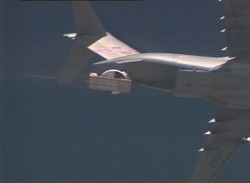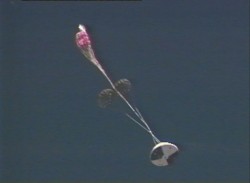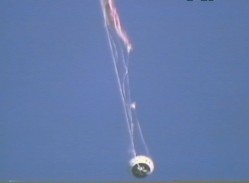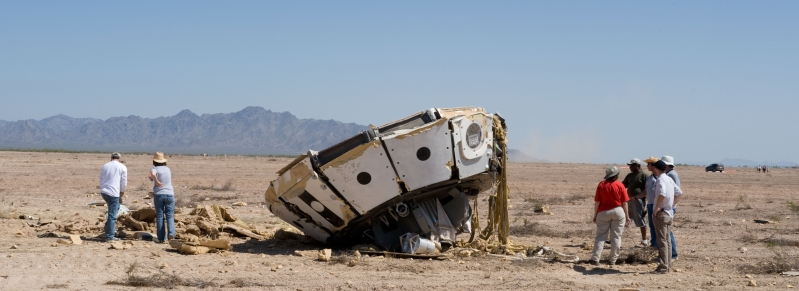[/caption]
As previously reported on the Universe Today, recent parachute test-drops for the Constellation Project have brought mixed results. The Ares I drogue parachute test appeared to perform flawlessly on July 24th, but the July 31st Orion test drop was a different story. Very early on in the parachute test, the “programmer parachute” (the first small parachute to be deployed, righting the descending crew module, setting Orion up for drogue deployment) failed after not inflating in the turbulent wake of the vehicle. This event set in motion complete parachute failure, ultimately forcing a hard-landing (crash) into the Arizona desert. Now NASA has released a video and pictures of the test…

On July 31st, hopes were high for a successful parachute test drop above the U.S. Army’s Yuma Proving Ground in Arizona. The week before, the Ares I re-usable booster rocket drogue parachutes had proven themselves, so pressure was on for the Orion analogue – the Parachute Test Vehicle (PTV) – to perform as it should.
A re-entering crew module has a complicated series of parachute deployments before it can land safely (a.k.a. a “soft” landing). Unfortunately, the July 31st test drop was anything but soft. Although the parachute deployment system performed as it should (i.e. the 18 parachutes opened at the correct time and in the correct manner), but the problem came right at the start of the chain: when the very first “programmer parachute” was deployed. As with any descending space vehicle, a programmer parachute needs to be deployed to ensure the crew module is a) the correct way up and b) set up for the critical “drogue parachute” deployment. The drogue reduces the vehicle’s velocity very quickly, moments before the main parachutes are deployed.

Alas, the programmer parachute never opened fully in the turbulent air behind the PTV, forcing the vehicle to swing wildly out of control. The drogue parachute had little chance to slow the descent as the spinning vehicle cased the inflating drogues to be ripped away. So the PTV went into freefall…
After falling for several seconds, the main parachutes made an appearance. Looking more like a party popper than a crew module, two of the main parachutes were ripped away like streamers, only one of the three parachutes remained connected. So its fate was sealed, the PTV was going to make a bone crushing hard-landing.
See the NASA video of the whole test, from drop to crash »

Oh well. I hope NASA has better luck next time. According to officials, this does not indicate an Orion technology failure, it was a “test technique failure” that was bound to frustrate the engineers on the ground. After all, the parachutes did deploy, they just didn’t open…
Suddenly the April hard-landing of the Russian Soyuz vehicle doesn’t seem so bad…
Source: NASA


…God thats a long way to fall.
I see the idea of a winged return vehicle in a whole new light.
More money down the drain.
Again with the “test technique failure” language. The general public saw a big object crash. Emphasis on the word “crash” (substitute words: boom, bang). Hey NASA, “test technique failure” may make you sleep better at night, but most of the average joes out there that saw this thing saw a failure. The PR spin wasn’t necessary…or even particularly effective. But, I will withhold final judgment until I test the language in my personal, everyday world. The next time I make something crash when the actual technology didn’t fail, I will call it a “test technique failure” and then conduct a survey to see how many people arrived at the same conclusion.
Weren’t they supposed to be leaning on “off-the-shelf,” proven technologies for this program? Granted it’s pretty early going, and there has to be a first test of everything. But it’s not like parachutes are the air in front of the bleeding edge of technology. I think I speak for all tech-watching Americans when I say, “Girl please. “
Well, now we know why the Russians have had so much trouble with their parachute systems. Their recent thump was only the most recent.
Much as I dislike the Shuttle, how about using the airframes and redoing the interiors?
r2k : W.O.R.D… they had all the required technology & data 40 years ago…where did it go?! 😉
I can’t help thinking that in ten or twenty years or maybe earlier, we’ll have to admit that the shuttles weren’t that bad after all. It’s just howling with the wolves now, isn’t it, the shuttle bashing. And every one is jumping on these “new” designs… Look at how flawless these were in the Russian days. Making all the same mistakes again now.
We’ll built new shuttles. We’ll have to. Without those two, stupid, preventable accidents, the shuttles would have been the crown of NASA, many new and updated ones built regularly, with weekly lifts to wherever we wanted, even the moon. It’s the decision makers that were flawed, not the shuttle design.
Parachute deployment for a cone-shaped ballistic capsule *should* be familiar territory by now,
But having said that, the real point, of course, is that this was learned with a cheap, unmanned test article. And you just saw *why* they’re done.
Most astronauts have engineering backgrounds themselves. Let there be no doubt that they’ll be watching the analysis of, and fixes to this situation, with great interest….
Well, I guess it’s a good thing that we get to see everything almost immediately. Not so much posturing and propaganda.
Impressive how well the camera tracked the capsule despite its not decelerating according to plan.
Would Orion have stabilised it it were allowed to freefall for a few more seconds befor the first chute deployed?
This is why I hate it when people rag on private spaceflight. OF COURSE their first launches fail!
New technologies have a learning curve that you have to pass. Duh.
Oh God , lets just adapt this Orion program with a Shuttle since the Shuttle is the greatest spacetruck NASA’s ever invented…We are gonna need new shuttles in a big way till we achieve the ability to build them in space.
Phil, how about this idea for a poll:
The question is simple:
Imagine you’re in the ISS with a choice.
How many would choose a parachute over a shuttle re-entry anytime now or in the near future?
Silly. What no one seems to notice or speak of is that the PILOT is to blame for the mishap. Why a total novice was used I don’t know..